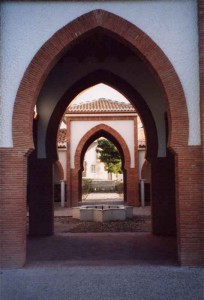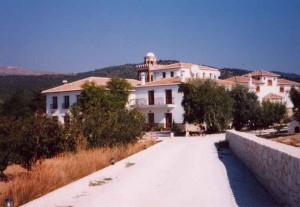Western
Europe’s first custom-built college of traditional Islamic learning
opens its doors to students  on
on
The madrasa is located in dramatic mountain terrain two hour’s drive north of the ancient Muslim capital of Granada. Dominated by the Azzagra (Al-Thaghra) Mountain, it symbolically straddles the medieval border between the Moorish Kingdom of Granada and Christian Castile. The local people whose hard work and vision have created the scheme are in many cases descendants of Spanish Muslims who endured centuries of oppression under the Inquisition, and declared their faith openly once more following the legalization of Islam in Spain in 1975.
 The
spiritual and scholarly guide of the community is Don Antonio Romero-Roman,
also known as Abd al-Samad, who publicly ‘reverted’ to Islam shortly after
the 1975 law was announced. A local landowner, and mayor of the nearby
town of Puebla de Don Fadrique (anciently Al-Bayda’),
he has the local connections, and the know-how, to bring to fruition the
dream of returning Islamic scholarship to Spain after centuries of clandestine
life.
The
spiritual and scholarly guide of the community is Don Antonio Romero-Roman,
also known as Abd al-Samad, who publicly ‘reverted’ to Islam shortly after
the 1975 law was announced. A local landowner, and mayor of the nearby
town of Puebla de Don Fadrique (anciently Al-Bayda’),
he has the local connections, and the know-how, to bring to fruition the
dream of returning Islamic scholarship to Spain after centuries of clandestine
life.
After studying
for almost a decade under traditional Maliki and Shafi‘i scholars in the
Middle East, including Imam Ahmad Mashhur al-Haddad, and Shaykh Muhammad
al-Alawi al-Maliki, Shaykh Abd al-Samad  returned
to Andalusia in 1993, and began work extending his family farm with a
view to making it a magnet for Muslim scholars and visitors. The first
task was to construct a mosque.Designed by the British architect Abd al-Lateef
Whiteman and officially opened in July, this has a capacity for five hundred
worshippers, and has already become one of the region’s most popular tourist
attractions.It honours the ancient traditions of Umayyad Andalusian mosque
design, but without seeking to be a simple replica, and engages creatively
with the current architectural idioms of modern
returned
to Andalusia in 1993, and began work extending his family farm with a
view to making it a magnet for Muslim scholars and visitors. The first
task was to construct a mosque.Designed by the British architect Abd al-Lateef
Whiteman and officially opened in July, this has a capacity for five hundred
worshippers, and has already become one of the region’s most popular tourist
attractions.It honours the ancient traditions of Umayyad Andalusian mosque
design, but without seeking to be a simple replica, and engages creatively
with the current architectural idioms of modern  rural
Spain. The minaret, with its echoes of the great Giralda minaret in Seville,
is classical, but not severely so, and frankly acknowledges its modern
materials by exposing its internal stairway to the mosque courtyard.
rural
Spain. The minaret, with its echoes of the great Giralda minaret in Seville,
is classical, but not severely so, and frankly acknowledges its modern
materials by exposing its internal stairway to the mosque courtyard.
Much teaching will take place within the mosque itself, according to time-honoured Andalusian Muslim tradition, but the complex also includes several lecture rooms, including a 300-seat theatre with video capabilities. There is a library with an extensive collection of books in Arabic and European languages. Nearby is the site of a sports complex, currently under construction; and there is also a swimming pool and a stable for Arab thoroughbred horses.
Abd al-Samad
explains that sport is not the only outdoor activity that will be available
to students. The complex lies at the centre of an 80-hectare farm, and
students will be encouraged to help with the almond and olive cultivation
which is the basis of its  self-supporting
economy, and also with the plum, apricot, apple and walnut trees, which
are irrigated with the help of ancient Moorish underground canals, one
of which leads to a spring famous in the region for its medicinal properties.
Farming here is entirely along organic lines (Shaykh Abd al-Samad is the
deputy president of the Andalusian Green Party), and one of the project’s
intentions is to return to Spain the agricultural wisdom which, under
eight centuries of Muslim rule, turned the peninsula into a garden celebrated
by the region’s Arab poets.
self-supporting
economy, and also with the plum, apricot, apple and walnut trees, which
are irrigated with the help of ancient Moorish underground canals, one
of which leads to a spring famous in the region for its medicinal properties.
Farming here is entirely along organic lines (Shaykh Abd al-Samad is the
deputy president of the Andalusian Green Party), and one of the project’s
intentions is to return to Spain the agricultural wisdom which, under
eight centuries of Muslim rule, turned the peninsula into a garden celebrated
by the region’s Arab poets.
The curriculum
focusses on intensive Arabic for the first two years, after which other
Islamic disciplines, centred on Hanafi and Maliki fiqh, will be taught.
Several of the tutors are from Spain and Latin America, but it is planned
to bring three or more scholars from Egypt and Syria to help with the
advanced, four-year degree course which, if all goes to plan, will be
on offer from 2003. As yet no Spanish university recognises the course,
but negotiations are underway with
The fifty-odd male and female students who will be welcomed at the madrasa next month come from all over Europe and the Spanish-speaking world, and it is thought that convert communities have furnished a large proportion of them. The muezzin of the mosque, Chilean-born Muhammad Qasim, explains that with the current rapid growth of Islam in Latin America, particularly in Peru, Argentina and Venezuela, at least half of the students may be native speakers of Spanish. Spanish and Arabic are the madrasa’s official languages, but non-Spanish speakers, particularly from France, have also been accepted as students.
‘This shows the world what European Muslims can do’, says Shaykh Abd al-Samad. ‘It is time we developed our own leadership, combining traditional scholarship and a Western identity. Islam can only be dynamic here if it is relevant, tolerant, and rooted in spiritual wisdom.’